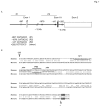Wild type p53 transcriptionally represses the SALL2 transcription factor under genotoxic stress
- PMID: 24040083
- PMCID: PMC3765348
- DOI: 10.1371/journal.pone.0073817
Wild type p53 transcriptionally represses the SALL2 transcription factor under genotoxic stress
Erratum in
- PLoS One.2014;9(8):e104307. doi: 10.1371/journal.pone.0104307
Abstract
SALL2- a member of the Spalt gene family- is a poorly characterized transcription factor found deregulated in various cancers, which suggests it plays a role in the disease. We previously identified SALL2 as a novel interacting protein of neurotrophin receptors and showed that it plays a role in neuronal function, which does not necessarily explain why or how SALL2 is deregulated in cancer. Previous evidences indicate that SALL2 gene is regulated by the WT1 and AP4 transcription factors. Here, we identified SALL2 as a novel downstream target of the p53 tumor suppressor protein. Bioinformatic analysis of the SALL2 gene revealed several putative p53 half sites along the promoter region. Either overexpression of wild-type p53 or induction of the endogenous p53 by the genotoxic agent doxorubicin repressed SALL2 promoter activity in various cell lines. However R175H, R249S, and R248W p53 mutants, frequently found in the tumors of cancer patients, were unable to repress SALL2 promoter activity, suggesting that p53 specific binding to DNA is important for the regulation of SALL2. Electrophoretic mobility shift assay demonstrated binding of p53 to one of the identified p53 half sites in the Sall2 promoter, and chromatin immunoprecipitation analysis confirmed in vivo interaction of p53 with the promoter region of Sall2 containing this half site. Importantly, by using a p53ER (TAM) knockin model expressing a variant of p53 that is completely dependent on 4-hydroxy-tamoxifen for its activity, we show that p53 activation diminished SALL2 RNA and protein levels during genotoxic cellular stress in primary mouse embryo fibroblasts (MEFs) and radiosensitive tissues in vivo. Thus, our finding indicates that p53 represses SALL2 expression in a context-specific manner, adding knowledge to the understanding of SALL2 gene regulation, and to a potential mechanism for its deregulation in cancer.
Conflict of interest statement
Figures







Similar articles
-
Sall2 is required for proapoptotic Noxa expression and genotoxic stress-induced apoptosis by doxorubicin.Cell Death Dis. 2015 Jul 16;6(7):e1816. doi: 10.1038/cddis.2015.165. Cell Death Dis. 2015. PMID: 26181197 Free PMC article.
-
SALL2 represses cyclins D1 and E1 expression and restrains G1/S cell cycle transition and cancer-related phenotypes.Mol Oncol. 2018 Jun;12(7):1026-1046. doi: 10.1002/1878-0261.12308. Epub 2018 May 21. Mol Oncol. 2018. PMID: 29689621 Free PMC article.
-
The proapoptotic gene SIVA is a direct transcriptional target for the tumor suppressors p53 and E2F1.J Biol Chem. 2004 Jul 2;279(27):28706-14. doi: 10.1074/jbc.M400376200. Epub 2004 Apr 22. J Biol Chem. 2004. PMID: 15105421
-
p53 and PPP1R13L (alias iASPP or RAI) form a feedback loop to regulate genotoxic stress responses.Biochim Biophys Acta. 2010 Dec;1800(12):1231-40. doi: 10.1016/j.bbagen.2010.09.002. Epub 2010 Sep 15. Biochim Biophys Acta. 2010. PMID: 20840860
-
ERp29 regulates response to doxorubicin by a PERK-mediated mechanism.Biochim Biophys Acta. 2011 Jun;1813(6):1165-71. doi: 10.1016/j.bbamcr.2011.03.003. Epub 2011 Mar 22. Biochim Biophys Acta. 2011. PMID: 21419175
Cited by
-
SALL Proteins; Common and Antagonistic Roles in Cancer.Cancers (Basel). 2021 Dec 15;13(24):6292. doi: 10.3390/cancers13246292. Cancers (Basel). 2021. PMID: 34944911 Free PMC article. Review.
-
Sal-like protein 2 upregulates p16 expression through a proximal promoter element.Cancer Sci. 2015 Mar;106(3):253-61. doi: 10.1111/cas.12606. Epub 2015 Mar 3. Cancer Sci. 2015. PMID: 25580951 Free PMC article.
-
The tumor suppressor protein p150(Sal2) in carcinogenesis.Tumour Biol. 2015 Feb;36(2):489-94. doi: 10.1007/s13277-014-3019-1. Epub 2015 Jan 22. Tumour Biol. 2015. PMID: 25608837 Review.
-
The transcription factor p53: not a repressor, solely an activator.Cell Cycle. 2014;13(19):3037-58. doi: 10.4161/15384101.2014.949083. Cell Cycle. 2014. PMID: 25486564 Free PMC article.
-
Sall2 is required for proapoptotic Noxa expression and genotoxic stress-induced apoptosis by doxorubicin.Cell Death Dis. 2015 Jul 16;6(7):e1816. doi: 10.1038/cddis.2015.165. Cell Death Dis. 2015. PMID: 26181197 Free PMC article.
References
-
- de Celis JF, Barrio R (2008) Regulation and function of Spalt proteins during animal development. Int J Dev Biol 52: 1-14. doi:10.1387/ijdb.072494mr. PubMed: 18033666. - DOI - PubMed
-
- Sweetman D, Münsterberg A (2006) The vertebrate spalt genes in development and disease. Dev Biol 293: 285-293. doi:10.1016/j.ydbio.2006.02.009. PubMed: 16545361. - DOI - PubMed
-
- Pincheira R, Baerwald M, Dunbar JD, Donner DB (2009) Sall2 is a novel p75NTR-interacting protein that links NGF signalling to cell cycle progression and neurite outgrowth. EMBO J 28: 261-273. doi:10.1038/emboj.2008.274. PubMed: 19131967. - DOI - PMC - PubMed
-
- Böhm J, Buck A, Borozdin W, Mannan AU, Matysiak-Scholze U et al. (2008) Sall1, sall2, and sall4 are required for neural tube closure in mice. Am J Pathol 173: 1455-1463. doi:10.2353/ajpath.2008.071039. PubMed: 18818376. - DOI - PMC - PubMed
Publication types
MeSH terms
Substances
Grants and funding
LinkOut - more resources
Full Text Sources
Other Literature Sources
Molecular Biology Databases
Research Materials
Miscellaneous

